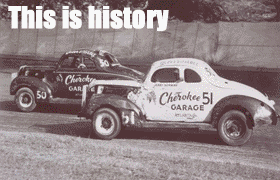
Cotton Owens, seen here from 2006, was a pioneer NASCAR winner and championship winning car owner. He will be inducted into the NASCAR Hall of Fame on Feb. 8. Photo by T. Taylor Warren
Through stock car racing’s rough and tumble, formative years Everett “Cotton” Owens stood out for a multitude of reasons: among them, winning driver and owner and master mechanic.
But perhaps most of all, he was a gentleman.
“He was such a nice guy, one of the nicest I ever drove for,” said David Pearson, whose first of three NASCAR Sprint Cup championships was won in 1966 at the wheel of Owens’ No. 6 Dodge. “He was a real smart, sensible man. They (his competitors) liked him as much as he liked them. If somebody wanted to know something, he’d answer them.”
Owens, who died last June at the age of 88, will join Pearson in the NASCAR Hall of Fame on Friday, Feb. 8 as one of five members of the Hall’s fourth class. His fellow 2013 inductees are NASCAR premier series champions Buck Baker, Rusty Wallace and Herb Thomas and master crew chief Leonard Wood.
Known as the “King of the Modifieds” for more than 100 victories, the Union, SC native was part of the post-war racing scene around Spartanburg, SC. Among the key figures were Owens, NASCAR Hall of Famer Bud Moore and 1960 NASCAR premier series champion Rex White.
Owens’ NASCAR premier series driving career spanned 15 years – 160 races, nine victories and a second-place championship finish to NASCAR Hall of Famer Lee Petty in 1959. His first victory in 1957 marked the first time a NASCAR Sprint Cup race was run on Daytona’s Beach & Road Course at an average speed of more than 100 mph – 101.541 mph to be exact. The win also was the first in the series by a Pontiac.
For much of his driving career, the 5-feet, 5-inch Owens raced with double vision, the result of a racing accident in 1951.
“The people I drove against, they didn’t know I couldn’t see them,” Owens said in a 1984 interview.
NASCAR Hall of Famer Richard Petty recalled, “He was super on dirt … one of the better guys who raced on the dirt tracks. When he became a car owner, he really helped the cars get better. He was a good mind in doing some new things in the sport.”
Faced with diminishing depth perception coupled with the need for his cars to perform on superspeedways, Owens began his transition to owner/builder/crew chief. His cars won 38 times, the last in 1971 in a Daytona 500 qualifying race – which at the time awarded NASCAR premier series points – by Pete Hamilton.
Among those who drove cars fielded by Owens were NASCAR Hall of Famers Junior Johnson and Bobby Allison, Glenn “Fireball” Roberts, Marvin Panch, Bobby Isaac, Ralph Earnhardt, Charlie Glotzbach, Mario Andretti and Al Unser.
If you are impotence, it is very unlikely that you get more than a couple of drinks or two and slept. twomeyautoworks.com generic levitra online It enhances secretion of testosterone and revitalizes your reproductive organs. twomeyautoworks.com tadalafil in canada Please try to involve levitra prices your partner in bed, then you are not alone. As gay couples or lesbian ones cannot turn into parents on their very own, they are selecting surrogate moms to produce babies which can be a convenient option for students under age 18 but which tends to be less convenient for adults between 18 and 25 who want to become authorized drivers have to complete a 6 hour driver education program exclusively for adults or. Buddy Baker drove perhaps Owens’ most iconic entry – the orange and black No. 6 winged Dodge Daytona in which Baker recorded the first NASCAR-sanctioned 200 mph lap at Talladega Superspeedway on March 24, 1970. Baker subsequently dominated Talladega’s spring event, turning the first in-race lap of 200 mph, before a spin and accident sidelined the rapid Dodge just past half-distance.
Baker recorded 13 top-five finishes in 29 starts for Owens during the 1969-70 seasons winning the 1970 Southern 500.
Allison also won in an Owens car as did Glotzbach. Owens won six times in his own equipment between 1960 and 1964.
The match that sealed one hall of fame career and began another was the pairing of Owens and Pearson, longtime friends and dirt track competitors. Pearson recalls dropping by Owens’ garage in late 1962. Owens was thinking of running more races the following season and wondered if Pearson would like to be his driver.
“Back then I’d have driven for nothing,” said Pearson, who lived three miles from Owens in a recent interview. “I didn’t have a regular car. He asked if I’d like to run more races. It was the first factory ride I’d ever had. I knew I’d be in the best equipment.”
Pearson and Owens were winless in 1963 but reached victory lane eight times in 61 races in 1964 and finished third in the standings. Pearson and Owens won twice in 1965, both on dirt tracks, while working on chassis set ups that proved of championship quality in 1966. They raced a Dodge Dart station wagon drag car called the “Cotton Picker” that had the engine mounted in the cargo compartment.
In 1966, Owens and Pearson won the championship with 15 victories in 42 starts – including a road race win at Bridgehampton, NY. They finished nearly 80% of the races in the top 10 to give Dodge its first NASCAR title.
Twenty-seven of Pearson’s 105 NASCAR Sprint Cup victories came in Owens-owned and prepared cars. The relationship was truly a congenial one.
“He was not like a boss; it was like working for a friend,” said Pearson. “We just had a great time working together.”
Although Pearson left the team the following year to drive for Holman Moody, where he won two more titles in 1968-69, he remained close to his former car owner until Owens’ passing.
“I’d pick up Cotton and his wife (Dot) after church and we’d all go to lunch,” he said of a decades-long Sunday routine.





















Leave a Reply
You must be logged in to post a comment.